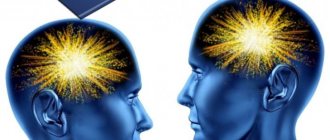- Tweet
I thought I could. I could come up with something so... Great. Brilliant. Special. Sometimes I want to think something “special”. And come up with some incredible idea. Or discoveries. Or be able to solve some difficult problem. Understand something global. But not a single thought is complete. And every day it becomes more and more difficult for me to think about anything. In my dreams, I quickly and easily solve complex problems, and I know for sure that I am smart, but in reality my head is simply filled with cotton wool. Maybe I'm just stupid? I'm trying and I can't. Or am I not even trying?
“I know for sure that I’m smart, but I can’t think” - such states in most cases are characteristic of a person with a sound vector. To create outstanding thought forms, to generate ideas, to solve complex problems, to reach important realizations - this is the natural purpose of a person with a sound vector. His innate desire and ability. The problem is that a person is not always aware of his desires and therefore cannot understand how to realize them. We will learn in detail about the desires of the sound vector at Yuri Burlan’s training “System-vector psychology”.
Silence in the mind
Try not to think for a while - as long as you can. Direct your attention to the spaces between thoughts, to the intervals of silence in the mind.
As a little trick to help with this exercise, I encourage you to ask yourself, “Where will my next thought come from?” Or even like this: “I wonder what color the next thought will be?”
After you ask yourself this question, there will be silence in your head, albeit for a short time. But it will be a special silence. You are not asleep, you are not intoxicated, you are not “counting crows” - you are alert, attentive, aware.
This state of silence in the mind in unity with mindfulness is called presence . It plays a vital role in a variety of spiritual teachings and is very useful for you and me.
Interesting experiment
The narrow opening does not allow one to see the rest of the universe. Psychologists conducted an experiment in which five blindfolded men were brought to an elephant. Each representative of the stronger sex stood at a certain part and had to describe the subject of the study. All participants described the elephant correctly, but none of them said what kind of animal it was. The context was correct, but the men's reasoning was limited by personal experience and rejection of another point of view. After their eyes were untied, the participants laughed together. It is these limitations that help describe the tunnel thinking that distorts reality.
Two types of thoughts
In the head of each of us, a “mental stirrer” or “word thresher” is constantly working. Pictures, reasoning, assessments, questions, dialogues with imaginary interlocutors, etc. constantly appear in the mind. In Eastern spiritual traditions, the human mind is compared to a restless monkey that constantly jumps and gallops.
No, I'm not against thinking at all. It’s just necessary to distinguish between mental efforts aimed at solving specific problems (how to order a book in an online store; what time to leave home in order to arrive at the airport on time), and chaotic, disorganized, automatic judgments about one thing or another .
Thoughts of the second type drag us down, we ourselves do not notice how, under their influence, we experience anxiety, depression, or anger.
It would be optimal to “turn on” rational, constructive thinking to analyze problems and solve specific practical issues, and the rest of the time to strive for a state of clear perception of everything that surrounds us and happens around us, but without unnecessary mental “chatter.” In the Tibetan teaching of Dzogchen this state is called rigpa .
Rule 7: Check the chain
This is the final rule of strong thinking. When you have outlined the solution to the problem and outlined the first action, do not rush to complete it. Remember: “Measure twice, cut once.”
You need to carefully look at the entire chain link by link. In this case, you must answer two questions for each link:
- Do you understand what needs to be done here?
- Will the result make it possible to move on to the next link?
And when you have gone through the chain, then answer the question along the chain as a whole:
Will the chain lead to the desired result?
If the answers to all questions are positive, then you can safely proceed to action.
From the book “How to become smarter”
From relaxation to transformation
The very first, easily achievable benefits from such discipline (or hygiene) of the mind are a feeling of peace, lightness, as well as clarity of thought, the emergence of creative ideas. But this is just the beginning. Once you strengthen your connection with the state of presence, your life will change greatly.
If we establish pure awareness as our mental base, a profound peace will emerge in our souls. And this is not a consequence of calm thoughts, as it might seem at first glance. This peace is an inherent property of pure presence - the fundamental principle, the original state of consciousness.
So-called "awakened" people - those who are almost constantly in this state - also have emotions and thoughts in their heads. But they do not lose themselves in the whirlpools of uncontrolled thoughts, they do not “fall” into negative experiences deeply and for a long time.
It seems surprising at first glance, but the state of awakening smoothes out the severity of suffering .
How it works? The fact is that we suffer not only from the troubles themselves, but also because we internally say “no” to them: we deny them, we protest against them, we object to their presence.
But they exist. This is a fact, this is a given, therefore our torment is vain and useless - it only increases discomfort. And in a state of pure awareness there is no resistance to anything: everything is accepted, everything is said “yes”, so there is no basis for suffering.
How to develop your thinking?
All people differ in intelligence, reaction speed and thinking mechanism. Some people are better at math problems, while others are better at humanities. All this is connected with genetics, upbringing, and the stages of development of one’s horizons. How can you develop your thinking?
First of all, you need to develop the ability to think logically. Even simple logical problems can be unsolvable not only for a child, but also for an adult. The second important aspect of free thinking is analytics. Without analyzing information, it is difficult to make the right decision. The next parameter of the ideal thought process is deduction
Attention to detail helps a person to grasp the problem from all sides, draw the right conclusion and not miss the little things. Finally, creative processes are an integral part of developmental activities
To get rid of tunnel thinking, you will have to work hard.
Changing your own rhythm of the thought process is a long journey, consisting of the development of logic and analytics, the use of a creative approach to solving problems, learning to objectively assess the entire situation as a whole and find the optimal solution. And Vikium simulators and courses will provide invaluable assistance in the complex development of thinking. Most of them have shown their effectiveness and are very popular. The course “Sherlock's Thinking” is perfect for developing logic. The “Development of Thinking” course is aimed at improving analytical abilities. “Creative Thinking” will help you become more creative and learn to find non-standard solutions in different situations.
“There is only a moment between the past and the future”
It is easy to discover that the state of presence, pure awareness, exists only in the present moment. More precisely, they exist completely outside of time: there is no time for this state - it is always “now”. The events of our lives always happen right now. Life always unfolds in the “now” and never otherwise.
When we remember the past (a conversation with our boss, a date, a walk in the park), only the process of remembering actually occurs, and it takes place in the present. If we think about the future (dream, plan), this is again a mental process that occurs in the present. What we think about (a kiss, an exam, a tooth extraction, a jump into the sea) will happen sooner or later, but it will happen in the present moment.
Taking into account this interesting fact, we come to the conclusion that we live our lives in a “skewed” state. After all, our head is usually occupied either with thoughts about the future or thoughts about the past. We are rarely 100% present in the present.
Clarity of thinking
Lack of clarity causes confusion, stress, depression and distraction in life. Clarity helps us understand our desires, set goals, focus on what matters, and take further action. The more clarity in life, the simpler and easier it is to realize yourself 100%.
- What areas and areas need clarity?
- Determining your true desires and dreams.
- Formation of daily routine and discipline.
- Improving your personal life and building relationships.
- Drawing up financial plans and strategies.
- Awareness of future expectations from life.
- Creating goals and plans for the future.
- Tips and exercises for mental clarity
Passage to the present
A purely practical question arises: how can you “emerge” from the stream of thoughts and “dive” into the present moment? There are many psychotechnics, practices, and exercises for this.
As they say, everything new is well forgotten old. This is where meditative techniques that are hundreds of years old come to the rescue.
Unlike the mind, which likes to “walk” in the past or the future, our body lives, feels and functions in the present. Based on this, many ways to take root in the present are based on body-oriented practices.
You can feel the present moment at any second just by directing your attention to your breath. Take several conscious breaths in and out, noticing how the air moves through your nose, throat, chest and abdomen. Now you no longer live in a mental movie, but in the real world.
In order to be more firmly rooted in the present, feel the warmth in your palms and mentally “scan” your body: what sensations does it have? Notice areas that are warm, tense, tired, or in pain. The main thing is don’t evaluate anything, don’t start thinking about it – just observe, be aware.
A more difficult, but very useful task is to perform any action without losing awareness, without losing presence. Try eating a piece of cheese, a cookie, an apple with full attention to the process. Forget about yourself as a person, “become” the taste, dissolve in the process of sensations. There is no need to think about anything here - get experience in its purest form.
Thanks to such experiments, the brain masters a new (compared to uncontrolled mental chatter) mode of operation. It is known that people sometimes come to the same state spontaneously.
For example, having learned about an incurable diagnosis, some discover a special sensitivity in themselves: they deeply enjoy the sun and rain, birdsong, flowers, and communication with loved ones. The “wall” of mental concepts disappears, and everything around is perceived amazingly alive, fresh, and clear.
Thinking what it is
Thinking is the highest level of human consciousness, allowing a person to navigate the world around him, accumulate experience, and form an idea of objects and phenomena. It is an internal system capable of modeling the patterns of the world around a person, predicting possible developments of events, analyzing what is happening and accumulating unique truths.
Main functions: setting a goal and planning its achievement, finding a way out of various situations, monitoring what is happening and assessing the degree of achievement of set goals based on personal motivation. In psychology, there are different types of thinking, both healthy and pathological.
Who needs rehabilitation after Covid?
Answered by Daria Tishina, neurologist, senior doctor at the Three Sisters Clinic
If a person has recovered from Covid without consequences, there is no need for rehabilitation. But if, after recovery, impairments persist, no matter what, and the person cannot return to normal life, this is an indication for rehabilitation. Its type depends on the severity of the consequences.
If a person can move independently and does not use an oxygen cylinder, but fatigue or shortness of breath prevents them from returning to their previous pace of life, they can undergo outpatient rehabilitation
: Comes to the clinic when it is convenient for him.
Together with a physical therapist, he trains endurance and breathing - and gets rid of fatigue and shortness of breath. Together with a neuropsychologist, it restores emotional stability and concentration. And together with an occupational therapist, he finds ways to save energy so that there is enough for both recovery and important matters. telerehabilitation
at the Three Sisters clinic : meet with your doctor and all the necessary specialists online.
Inpatient rehabilitation
It is a must for those who have limited mobility, who are oxygen dependent, and who have suffered a stroke during their illness. How does it work? The attending physician supervises the process, the physical therapist re-teaches the person to sit and walk, the occupational therapist helps to be independent in everyday life, the neuropsychologist restores lost cognitive skills and helps not to fall into despair and depression. Together, specialists select the correct load for a person, monitor his condition every day and adjust methods if necessary.
You can recover from a moderate form of Covid quite quickly: usually after one to two weeks
in the clinic, a person performs daily duties without problems.
But someone who has been seriously ill and cannot walk or sit after the illness needs more time. It will take a week or a week and a half to relearn how to sit and start moving in a wheelchair, and about another week to perform short and simple operations while standing, for example, walking to the toilet in the ward. To fully recover, you need at least another month
. Sometimes irreversible changes in the lungs develop, and a person will no longer be able to completely return to their previous life. But even then, rehabilitation helps him to be more mobile and take care of himself.
Forms
In psychology, the main forms of thinking are distinguished, including concept, judgment and inference:
- The concept forms a person’s idea of surrounding phenomena and objects; this form is inherent only in verbal speech and allows one to combine objects and phenomena according to some characteristics. Concepts are divided into concrete (true meanings of an object or phenomenon “house”, “child”) and relative (depending on the perception of different people, for example, what good and evil are). The content of existing concepts is revealed in speech through judgments.
- Judgment - refers to a form that represents a denial or statement about the world around us or a certain object. The formation of judgments is possible in two ways: the perception of concepts that are closely interrelated or obtained in the form of an inference.
- Inference represents the formation of a new judgment based on two or more existing ones initially. Any conclusion is formed as a chain of well-founded ideas. The ability to make inferences depends on the stage of development of thinking; the higher it is, the easier it is for a person to find a solution to a certain problem.
All inferences are divided into inductive and deductive. In the first case, the judgment moves from a single concept to a general one, and deductive, on the basis of existing general ones, a whole group of phenomena or judgments is generalized into one general one.
Methods of thinking involve different levels, where at each stage certain goals are achieved: collection of information, analysis of available data and inference as a guide to action or inaction.
Why is limited thinking dangerous?
The flight of thought should not be limited to a narrow corridor. The inability to think broadly is called tunnel thinking in psychology. Philosophers and psychologists have repeatedly sought an answer to the question of what exactly is the danger of limited thinking.
Nothing limits a thinking person more than himself. Tunnel thinking leads to sad consequences, failures and lack of self-confidence. Examples of stories with a bad ending can be heard more often than with a happy one. Without covering the whole picture, a person follows the beaten path, does not see other options for getting rid of the problem and cannot make an appropriate decision. All this inevitably leads to a bad ending - the inability to fight, the fading of enthusiasm, the reluctance to solve anything due to past unsuccessful attempts.
Cons of Tunnel Thinking
Let's take a closer look at the disadvantages of narrow thinking:
- Dividing everything that happens into “black and white”. The absence of halftones makes it difficult to grasp the essence, forces you to adhere to traditional views, and prevents you from drawing your own conclusions.
- Categorical judgments. A person cannot agree with someone else’s opinion and even listen to it. He habitually rejects everything new because it scares him.
- Labeling. The individual considers himself right, while in fact everyone is right in their own way. It’s worth trying to see not only your part of the problem, but also to evaluate it through someone else’s eyes, to expand your horizons.
- Concentrating on the negative. Any problem that is assessed adequately becomes an invaluable experience, its own “getting in trouble.” A person with a narrow mindset often looks for people to blame instead of remembering life lessons.









